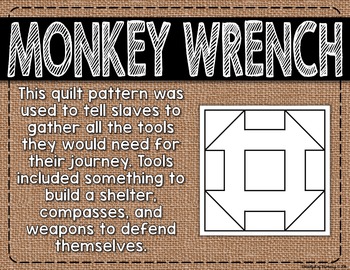Freedom Quilts - MINI UNIT
Pocketful of Primary
46k Followers
Grade Levels
1st - 4th
Subjects
Resource Type
Standards
CCSS1.MD.C.4
CCSS2.MD.D.10
CCSS2.OA.C.4
CCSS3.OA.A.1
CCSS3.NF.A.1
Formats Included
- PDF
Pages
35 pages
Pocketful of Primary
46k Followers
What educators are saying
This was such a great resource to use in conjunction to our unit on the Underground Railroad. The students loved the creative projects and I loved the math extension projects! It was a great way to integrate this concept into all subject areas.
This was a great addition to my CKLA civil war unit. My students loved learning about the different quilt patterns and making their own quilts.
Description
This freedom quilts mini unit is the perfect addition to your social studies curriculum with 4 different math connections!
This freedom quilts mini unit includes information pages to give students background knowledge on the underground railroad and the use of freedom quilts, printable of quilt patterns, and 4 different math connection printables. There are also book ideas to read aloud to your class on the topic!
The following are included in this product:
- 16 information pages (these can be projected on the board or printed)
- 7 quilt pattern printables
- 2 "Create Your Own" quilt pattern printables
- Freedom Quilt Geometry printable
- Freedom Quilt Graphing printable
- Freedom Quit Arrays printable
- Freedom Quilt Fractions printable
I hope you and your kiddos enjoy!
This freedom quilts mini unit includes information pages to give students background knowledge on the underground railroad and the use of freedom quilts, printable of quilt patterns, and 4 different math connection printables. There are also book ideas to read aloud to your class on the topic!
The following are included in this product:
- 16 information pages (these can be projected on the board or printed)
- 7 quilt pattern printables
- 2 "Create Your Own" quilt pattern printables
- Freedom Quilt Geometry printable
- Freedom Quilt Graphing printable
- Freedom Quit Arrays printable
- Freedom Quilt Fractions printable
I hope you and your kiddos enjoy!
Total Pages
35 pages
Answer Key
N/A
Teaching Duration
4 days
Report this resource to TPT
Reported resources will be reviewed by our team. Report this resource to let us know if this resource violates TPT’s content guidelines.
Standards
to see state-specific standards (only available in the US).
CCSS1.MD.C.4
Organize, represent, and interpret data with up to three categories; ask and answer questions about the total number of data points, how many in each category, and how many more or less are in one category than in another.
CCSS2.MD.D.10
Draw a picture graph and a bar graph (with single-unit scale) to represent a data set with up to four categories. Solve simple put-together, take-apart, and compare problems using information presented in a bar graph.
CCSS2.OA.C.4
Use addition to find the total number of objects arranged in rectangular arrays with up to 5 rows and up to 5 columns; write an equation to express the total as a sum of equal addends.
CCSS3.OA.A.1
Interpret products of whole numbers, e.g., interpret 5 × 7 as the total number of objects in 5 groups of 7 objects each. For example, describe a context in which a total number of objects can be expressed as 5 × 7.
CCSS3.NF.A.1
Understand a fraction 1/𝘣 as the quantity formed by 1 part when a whole is partitioned into 𝘣 equal parts; understand a fraction 𝘢/𝑏 as the quantity formed by 𝘢 parts of size 1/𝘣.





